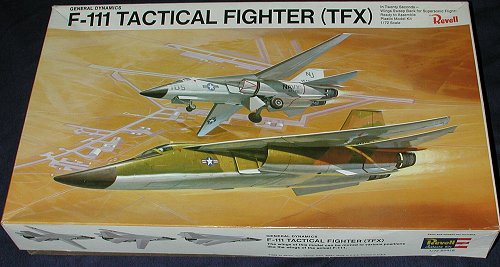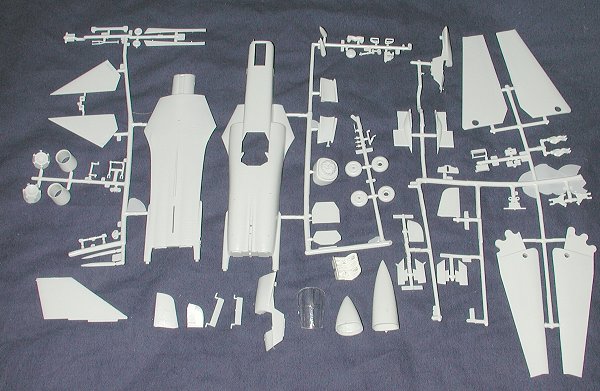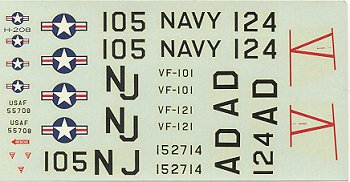
|
KIT: |
Revell 1/72 TFX (F-111) |
|
KIT # |
H-208 |
|
PRICE: |
Long OOP |
|
DECALS: |
Three versions |
|
REVIEWER: |
|
|
NOTES: |
1969 boxing |

|
HISTORY |
The TFX (Tactical Fighter eXperimental) was born. Features of this plane were the ability to fly at supersonic speeds and low level (for the Air Force) and the ability to carry the large Phoenix missiles and have swing wings (for the Navy). The swing wings were a hot item in the 1960s and the Navy liked the idea as it helped carrier stowage, where space is at a premium. The Navy plane had longer wings to help slow down landing speeds for the carrier. Both had a new Cockpit Escape Module where the entire cockpit would be ejected in case of disaster. They also used afterburning turbofan engines, a first for both services and Pratt and Whitney. General Dynamics would build the USAF F-111A version while Grumman would do the Navy's F-111B.
Well, things just didn't go as
well as hoped. There was trouble with the engines not providing full
thrust. The escape module added a lot of weight and just wasn't reliable
enough. The special low level radar that hooked into the auto-pilot for
terrain guidance (F-111A) just was too rough and shook the plane rather
severely. The Navy's F-111B was a huge aircraft for the job of fleet
protection, and frankly, the Navy just never wanted the plane so fought
it at every chance. Then we will go into the usual cost overruns. This
time it was just too much. The Navy had their 6 prototypes and used them
to get the Phoenix system to reliably operate for the plane they really
wanted, the F-14 Tomcat. The USAF was then to be the only American
operator of the type and after more development, it turned into an
excellent strategic bomber and tactical strike aircraft. Grumman got more
experience with swing wings so it could properly develop the Tomcat.
|
THE KIT |

This is the second boxing of this kit, the initial run being done in 1966. Other than the sturdiness of the box, they are identical. I bought mine at a swap where the original owner had started painting the cockpit (white for some odd reason). Detail is raised and though there isn't much of it, what is there is well done. Options include a removable cockpit escape system, swing wings, moveable horizontal stabilizers, a radar set, and retractable landing gear. Both nose cones and wing extensions for the F-111B are provided. No wing pylons or missiles are given. Thanks to the retractable landing gear, there is no gear well detail.
The detail is raised and there are ejector pin marks all over the place on gear door insides, ventral strakes and other parts. No sink areas were noted but there is some flash on one of the sprues. I can tell you from experience that you can get all the bits to operate, but one has to be very careful in construction as some of the finer bits have a tendency to break (like the horizontal stab hinges). The different radomes are build to just push on so they can be removed and the cockpit section has tabs so it can also be removed.
 Instructions are quite good
for the time with several construction step drawings. Only generic color
info is provided in the construction steps and the decals/camo drawings.
Markings are provided for three aircraft. One is a generic F-111A in SEA
camouflage, but with the light grey underside, a color only used briefly as
most USAF F-111s had the bottom painted black for night ops. The other two
are for USN aircraft in the then-standard light gull grey over white. Two
units, VF-101 and VF-121, both training squadrons who were to get the plane
are provided. Needless to say, the type never got that far so they are, for
all intents and purposes, to be considered fictitious. Considering the 30
plus years these decals have been around, they are in remarkably good shape
and barely beginning to yellow.
Instructions are quite good
for the time with several construction step drawings. Only generic color
info is provided in the construction steps and the decals/camo drawings.
Markings are provided for three aircraft. One is a generic F-111A in SEA
camouflage, but with the light grey underside, a color only used briefly as
most USAF F-111s had the bottom painted black for night ops. The other two
are for USN aircraft in the then-standard light gull grey over white. Two
units, VF-101 and VF-121, both training squadrons who were to get the plane
are provided. Needless to say, the type never got that far so they are, for
all intents and purposes, to be considered fictitious. Considering the 30
plus years these decals have been around, they are in remarkably good shape
and barely beginning to yellow.
|
CONCLUSIONS |
Well, I can tell you that serious builder will not want this kit. Its toy-like features make it only for the collector or someone wanting a nostalgic model. It is also a rather fussy build with all those working gizmos. It is still the only F-111B ever kitted in 1/72, and your editor has built both versions over the years.
Kit courtesy of me and my constant digging through the vendor's tables at swap meets!
If you would like your product reviewed fairly and fairly quickly by a site that has over 200,000 visitors a month, please contact me or see other details in the Note to Contributors.